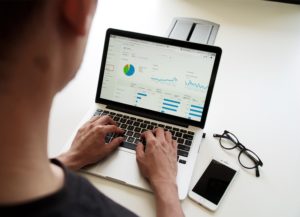Google Analytics is a completely free web analytics tool provided by Google that anyone with a website can use to automatically pull in stats on their website’s performance, to track and measure data on traffic and website visitors.
Chris Hall, Marketing Manager at Charity Digital says: “It’s easy to be put off by the home screen alone, but the benefits of getting a basic understanding of Google Analytics can provide big rewards for any charity. Scratching the surface you can understand more about your audience, who they are, where, when and how they are interacting with your website and what content is and isn’t working – allowing you to make those data-driven decisions that help you achieve your charity’s goals.”
The word data itself can be intimidating, or presumed to be just for techies, but it can be incredibly useful if charities know what questions to ask. Charities can use Google Analytics make in-depth analysis of important data, answering questions such as:
- Who is visiting my website?
- Where are they coming from/how are they finding it?
- What tactics are driving the most people to my website?
- What pages, blog content or information are people most/least interested in?
- How many of these visitors are donating/supporting?
- Who is donating/supporting and why?
- What are they searching for on my website?
- Are there any groups we aren’t reaching as effectively as we could be?
Data analytics is a vital component to continuously improving your website and ensuring your website users take the actions you want them to, whether that’s donating, signing up to be a regular supporter, volunteering, getting involved in programmes or volunteering, or getting to the information and advice they need. It can also be used for delivering easily digestible reports and data visuals to stakeholders.
However, Google Analytics has a lot of features, and can get complex. A first look can seem like information overload, so how can charities get to know the platform?
For more on how to access Google Analytics, check out Google’s Help Center.
See also: Five free efficiency-driving tools for charities
Step 1- Do your homework
Google’s own online learning resources include a Google Analytics for Beginners course, which is a useful place to start. The course includes instructions on how to set it up your platform, navigate the interface and set up filters and dashboards. The free video series also demonstrates how to analyse basic audience, acquisition, and behavior stats (and what these are), set up goals and campaign tracking, and how to create basic reports.
This article from digital marketing expert Fran Swaine is a good introduction to some of the most useful reports charities can run, and Charity Digital trustee Zoe Amar has some great advice on the kinds of data to measure and track.
Once you’ve familiarised yourself with the basics, the Advanced Google Analytics course helps you learn about some of the other more complex features and tools available in a bit more depth, like setting up advanced filters, tracking click events, and analysing data according to channel, audience and more.
Google offers a free certification in Google Analytics, which everyone involved in charity digital could benefit from as it goes into more depth about the strategy behind website analytics, and setting and tracking goals as part of that strategy. For an introduction to building your charity’s data analytics strategy, we recommend this chapter from Skills Platforms’ Charity Digital Toolkit.
It’s also worth checking out charity case studies for real world examples on what can be achieved – such as this one from the American Cancer Society and how they increased donations by 5.4% using the platform.
See also: The data skills every successful charity needs
Step 2- Dive in and start experimenting
Google Analytics is a powerful tool and it can do a lot. First steps should revolve around simplifying it to the most important, core questions you want to ask, based on a clear understanding of your website’s goals and what you want users to do. Then the only way to learn is really to get stuck in and have a look at your site’s information.
As we explain in our blog over on the Charity Digital site, information on Google Analytics includes: demographics, acquisition, behaviour, events and goals.
Demographics can provide you with a useful snapshot of the age, gender and geographic location of individals visiting your site, as well as which device they are using, which charities can use to create ‘user personas’ to tailor their content to specific audiences.
After all, a 40 year old stay at home mum using her laptop at home might have very different expectations than a 15 year old boy on his iPhone. For example, should you find out that most of the users on your site are over 65, it could be worth improving the readability and navigation.
Acquisition is another vital stat which shows you the journey that users take to and through your site. It’s not always completely accurate due to the fact that people can turn off Google’s tracking cookies, but can give you a general idea of where users are coming from the most, whether through search engines, social media, email newsletters, Google ads or another website.
This can allow you to adjust your strategy according to which channels are driving the most traffic and invest less into the ones that aren’t. It can also help you understand what people are typing into Google to find your site.
Behaviour is there things get really interesting – this allows you to see what people are doing once on your site, the pages they are interacting with, how much time they’re spending on them and even what time of day they are visiting.
You should be working from a hypothesis of what you expect people to be doing on your site, which you can then compare to their actual behaviour. This should give you an idea of what is working and what to tweak. For example, if you find that lots of people are visiting your donate page but aren’t spending any time there, it may be that the donation process isn’t simple or clear enough.
This sort of insight can be combined with tools such as HotJar, which enable you to see in more granular detail exactly where people are clicking or hovering on a particular page.
Events and goals are some of the most useful functionalities of Google Analytics. Events represent user interactions with content, whether a click or a dowload, watching a video or filling out a form, so you can see exactly how many people are fulfilling the actions you want them to.
You can set up specific goals for what you want users to do, tracking activites including events automatically, so that metric is always available to you. Goals measure how well your site is filfilling its objectives. Defining goals is a fundamental component of any data analytics strategy and can be done easily in Google Analytics.
If you want to know more about the process of setting up goals there’s a useful step-by-step guide here.
This is just a very simple introduction to what can be done in Google Analytics, but we hope it gives your charity some inspiration and a useful starting point.
Up Next



Article source: https://www.charitydigitalnews.co.uk/2019/08/29/how-charities-can-get-started-with-google-analytics/
